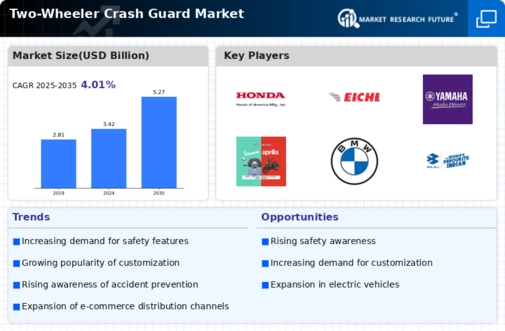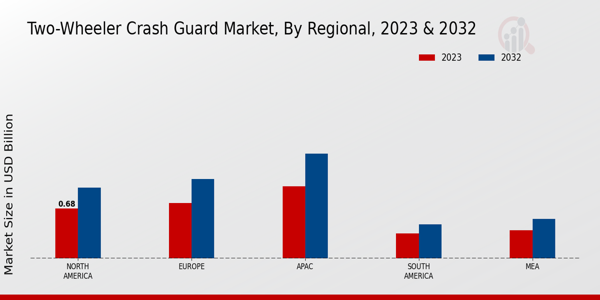Market Growth Projections
The Global Two-Wheeler Crash Guard Market Industry is poised for substantial growth, with projections indicating a market value of 3.42 USD Billion in 2024 and an anticipated increase to 5.27 USD Billion by 2035. This growth trajectory suggests a compound annual growth rate of 4.02% from 2025 to 2035, reflecting the increasing demand for safety equipment among two-wheeler riders. The market's expansion is likely influenced by various factors, including rising safety awareness, technological advancements, and regulatory support, all contributing to a more robust industry landscape.
Rising Two-Wheeler Ownership
The surge in two-wheeler ownership globally is a pivotal driver for the Global Two-Wheeler Crash Guard Market Industry. As urbanization accelerates and populations grow, more individuals are opting for motorcycles and scooters as a primary mode of transportation. This trend is particularly evident in developing countries, where affordability and convenience drive two-wheeler sales. Consequently, the demand for safety accessories, including crash guards, is expected to rise in tandem with ownership rates. This correlation suggests a robust market potential, as more riders seek to protect themselves and their vehicles from potential accidents.
Increasing Road Safety Awareness
The Global Two-Wheeler Crash Guard Market Industry is experiencing growth due to heightened awareness regarding road safety among riders. Governments and organizations are actively promoting safety measures, leading to an increase in demand for protective gear. For instance, various campaigns aimed at educating motorcyclists about the importance of crash guards have emerged, resulting in a more informed consumer base. This shift in perception is likely to drive the market, as riders seek to enhance their safety while on the road. The industry's growth is further supported by statistics indicating that the market is projected to reach 3.42 USD Billion in 2024.
Regulatory Support and Standards
The Global Two-Wheeler Crash Guard Market Industry is bolstered by regulatory frameworks that mandate safety standards for two-wheeler accessories. Governments across various regions are implementing stringent regulations to ensure that crash guards meet specific safety criteria. This regulatory support not only enhances consumer confidence but also encourages manufacturers to invest in higher-quality products. As compliance with these standards becomes essential, the market is likely to witness an increase in demand for certified crash guards. This trend aligns with the industry's overall growth, as safety regulations continue to evolve and adapt to emerging technologies.
Technological Advancements in Materials
Innovations in materials used for manufacturing crash guards are significantly influencing the Global Two-Wheeler Crash Guard Market Industry. The introduction of lightweight yet durable materials, such as advanced polymers and composites, enhances the effectiveness of crash guards while minimizing added weight. This technological progress not only improves rider safety but also appeals to manufacturers aiming to create more efficient products. As a result, the market is likely to benefit from these advancements, with projections indicating a growth trajectory that could see the industry valued at 5.27 USD Billion by 2035, reflecting a compound annual growth rate of 4.02% from 2025 to 2035.
Growing E-Commerce and Online Sales Channels
The expansion of e-commerce platforms is transforming the Global Two-Wheeler Crash Guard Market Industry by providing consumers with greater access to a variety of products. Online retailers are increasingly offering a wide range of crash guards, catering to diverse consumer preferences and budgets. This shift towards digital shopping not only enhances convenience but also allows for competitive pricing and better product comparisons. As more consumers turn to online channels for their purchasing needs, the market is likely to see a significant increase in sales, further propelling the industry's growth.














